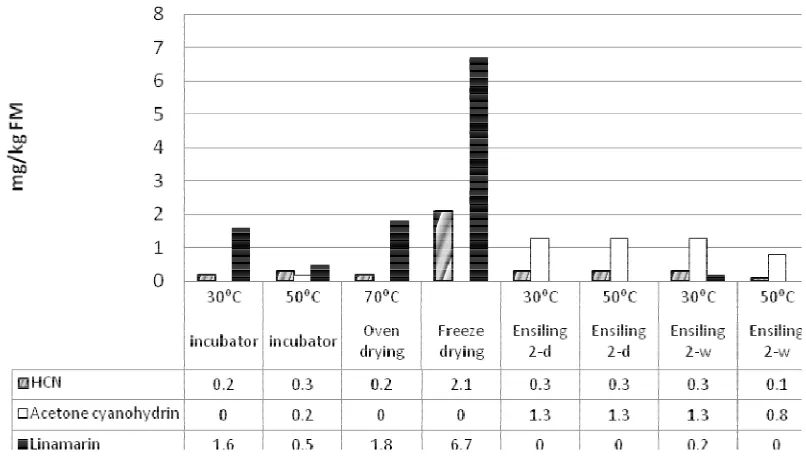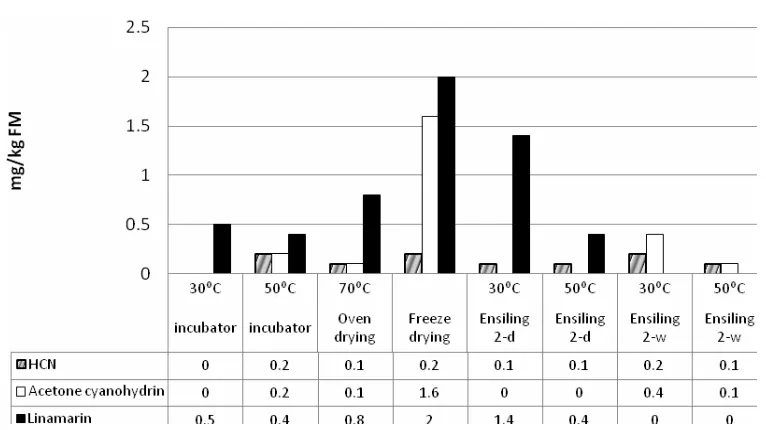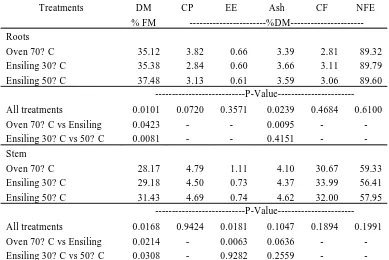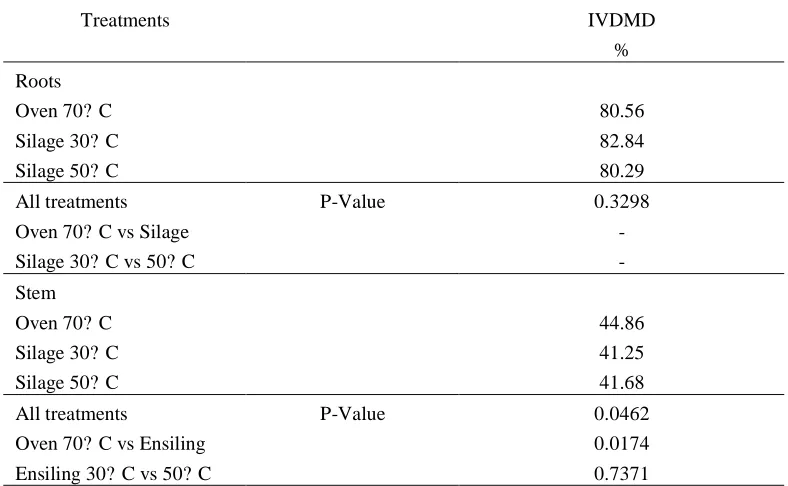EFFECTS OF DRYING AND ENSILING METHODS ON CYANIDES CONTENTS AND
CHEMICAL COMPONENTS OF CASSAVA ROOTS AND STEMS
B. Rahmi1, Y. Yanti2, S. Mizumachi3, J. Achmadi2, Y. Kawamoto3, and A. Purnomoadi2 1Department of Agriculture, Municipal of Semarang,
Jl. Kompak No.2 Pedurungan, Semarang 2Faculty of Animal Agriculture, Diponegoro University,
Campus drh. Soejono Koesormowardojo-Tembalang, Semarang 50275 3Tropical Grassland Laboratory, University of the Ryukyus,
1 Senbaru, Nishihara-cho, Okinawa, Japan
Received October 14, 2008; Accepted November 19, 2008
ABSTRACT
The objectives of this experiment was to compare the drying and ensiling methods to reduce cyanides contents in cassava, as well as related nutrient components. This experiment used roots and stems of cas-sava, fermented juice of epiphytic lactic acid bacteria (FJLB) and molasses. A completely randomized design was used in this experiment for 8 treatments. The treatments were 30oC incubator, 50oC incubator, 70oC oven drying, freeze drying, 2 d incubator 30oC ensiling, 2 d incubator 50oC ensiling, 2 w incubator 30oC ensiling and 2 w incubator 50oC ensiling. The contents of HCN, acetone cyanohydrin, linamarin, proximate components and in vitro dry matter digestibility were determined in each treatment. The result of this experi-ment showed that the contents of HCN and linamarin in ensiled cassava roots were lower (p<0.01) than in dried cassava roots. There were no significantly different on residual HCN among treatments in cassava stems. The content of linamarin was higher in freeze drying than that in heat drying methods (p<0.05). There was an opposite pattern of acetone cyanohydrins and linamarin content of roots and stems. The content of dry matter (DM) in 30oC ensiling was lower than in 50oC ensiling (p<0.05). The content of ash increased in cassava roots silage (p<0.01), meanwhile the decreasing of ether extract content was occured in cassava stem silage (p<0.01). Ensiling method was more effective to reduce cyanide than the drying method, and cassava silage showed a proper qualification as feed.
Keywords: Drying, Ensiling, Cyanides, Cassava
ABSTRAK
Penelitian ini bertujuan membandingkan metode pengeringan dengan ensilase untuk menurunkan kandungan sianida, serta mengetahui komponen-komponen kimia lain yang terkandung dalam umbi dan batang ketela pohon. Materi yang digunakan adalah batang dan umbi ketela pohon, fermented juice of epiphytic lactic
acid bacteria dan molasses. Penelitian menggunakan rancangan acak lengkap (RAL) dengan 8 perlakuan.
kandungan abu terjadi pada silase umbi ketela pohon (p<0,01), sedangkan pada silase batang ketela pohon memperlihatkan penurunan kandungan lemak kasar (p<0,01). Pada penelitian ini diketahui bahwa metode ensilase lebih mampu menurunkan kandungan sianida dibanding metode pengeringan, serta silase umbi dan batang ketela pohon memenuhi kualifikasi sebagai bahan pakan yang baik.
Kata kunci :Pengeringan, Ensilase, Sianida, Ketela Pohon
INTRODUCTION
Cassava is one of important plants in tropical coun-tries including Indonesia. This plant is well known for its adaptability to poor soil condition and resistant to drought. In Indonesia, cassava yields about 6-10 ton per hectare (Indonesian Ministry of Research and Technology, 2000). Some parts of this plant are con-sumed by human (i.e. young leaves and roots), and another parts are used as alternative feed stuff.
Various parts of cassava plant, including tubers, stems and leaves are used for animal feed. The aerial part of the plant comprising of stems, branches and leaves showed to have protein content as high as pelletized for feed. By using cassava product for 70% in livestock rations, it is estimated that 100 kg of poul-try meat, 5 kg of pork and 200 eggs could be supplied for 2.3 billion people in the tropics (Montaldo, 1977). Gomez (1991) reported that performance of growing calves, goats, sheep and steer have been improved by incorporation of cassava in the diet.
The utilization of cassava as feed has a restriction due to the presence of cyanide in all tissues. Chronic sub-lethal dietary cyanide has been reported to caused some reproductive effects including lower birth rates and an increased number of neonatal deaths, impaired thyroid function and behavioral effects including in-creasing ambivalence and slower response time (Food Standard Australian New Zealand, 2005). Further-more, the lethal doses of hydrocyanide (HCN) were 0.66 mg/kg body weight (BW) for rabbit and 2.0 mg/ kg BW for cattle and sheep.
The disadvantage of cyanide can be overcome by some process methods, such as sun-drying, artificial drying and ensiling. Since cassava root contains about 61% water, coupled with the solubility of its
cyano-genic glucoside component, the dehydration (dewa-tering) process results in a substantial reduction in the content of this toxin in the pressed pulp. Drying is carried out using solar radiation (sun drying) or elec-tric or fuel dryers (artificial drying) depending on eco-nomic viability. The ensiling process causes the integration of the intact glucoside via marked cell dis-ruption, drop in pH of ensiled medium and intense heat generation. Gomez and Valdivieso (1988) re-ported that the ensiling cassava chips reduced the cyanide content to 36% of the initial value after 26 weeks ensiling period. All methods reported above proved that hydrocyanide content in cassava could be reduced, but comparison of two methods (drying and ensiling) remained to be clarified.
The aim of this experiment was to compare the drying and ensiling methods to reduce the cyanides contents in cassava. Other related nutrients of cassava were also evaluated.
MATERIALS AND METODHS
Materials
Materials used in this experiment were cassava (Manihot ezculenta crantz) roots and stems, which harvested from experimental field at Faculty of Agriculture, University of The Ryukyus, Okinawa, Japan. A fermented juice of epiphytic lactic acid bacteria (FJLB) and molasses were used for additive in silage making.
Methods
Experimental Design
Preparation of Fermented Juice of Epiphytic
Lactic Acid Bacteria
Fermented juice of epiphytic lactic acid bacteria (FJLB) was prepared by incubated Napier grass juice for 2 d prior to silage making. Twenty five grams of fresh Napier grass was macerated with 50 ml of distilled water using blender. The macerate was then filtered through a sterilized double layer of cheesecloth and the filtrate was put into 100 ml flask. About 1% (w/v) of glucose was added into the filtrates, and were then shaken well and kept in an incubator for 2 d at
30oC (Bureenok et al., 2005).
Silage
Cassava roots or stems were chopped into 1-2 cm length and were weighed for approximately 100 grams was then added by 1% (v/w) FJLB and 1% molasses. These mixtures were packed into plastic bags and sealed by vacuum packaging machine.
Drying Methods
Cassava roots or stems were chopped into 1-2 cm length. Approximately 100 grams of that cassava roots or stems was packed into paper bag and put it in the incubator or oven dryer. The temperature of incubator was adjusted at 30oC and 50oC. Each treatment was set for 2-d long.
Chemical and Statistical Analysis
Each treatment was analyzed for HCN, acetone cyanohydrins and linamarin contents using acid hydrolysis method (Bradbury et al., 1991) and continued with spectrophotometer by the method of O’Brien et al. (2007). Ether extract (EE), ash, crude protein (CP) and crude fiber (CF) was analyzed using
the method described by AOAC (1985) for oven at 70oC and 2-w ensiled methods. In vitro dry matter digestibility (IVDMD) was also oven dried at 70oC and 2-w ensiled methods using pepsin-cellulose method as described by Aufrere (1982; cited by Forejtova et al., 2005). Data result was analyzed us-ing SAS GLM Procedure and was continued by con-trast if significant different was found (p<0.05).
RESULTS AND DISCUSSION
Cyanides Contents of Cassava Roots
The drying and ensiling reduced linamarin, acetone cyanohydrin and HCN. The reduction of linamarin, acetone cyanohydrin and HCN decreased potential toxicity of cassava as feed. These three cyanides types have different rates of toxicity. Linamarin was more dangerous in ruminant (Majak et al., 1990) because ruminal microorganisms have capacity to degrade cyanogenic glycosides and release HCN which is rapidly absorbed from rumen into bloodstream. In non ruminant, acetone cyanohydrin would be break downed rapidly to cyanide under alkaline condition in gut, but about half linamarin may unchanged, and pass through the body (Bradbury et al., 1999). Therefore, HCN and acetone cyanohydrin are more dangerous for non ruminant than linamarin when present in comparable amount.
The content of HCN and linamarin in drying methods was higher than that in ensiling methods (Figure 1). This means that ensiling method more pronounced in reducing HCN and linamarin content of cassava roots than that of drying method. Brauman
et al. (1996) stated that in fermented cassava root,
that the level of linamarase activity present in intact roots is sufficient to detoxify cyanogens content with-out help from any microbial linamarase. Neverthe-less, if bacteria do not directly detoxify cassava roots, they could degrade linamarin by destroying cell wall. The present experiment found that ensiling meth-ods had similar effect with oven drying method in re-ducing HCN content of cassava roots. This obser-vation explained that microbes in silage support to degrade linamarin faster than reducing free cyano-gens. The reduced of HCN in this study by 2 weeks ensiling might not be a maximum reduction, because HCN content reached a minimum and stable condi-tion after 56 days of ensiling (Chhay et al., 2001).
There was an opposite pattern of acetone cyanohydrin content with linamarin content. The linamarin content was low while the acetone cyanohydrin content was high and vice versa (Figure 1). This condition explained that acetone cyanohydrin content was influenced by hydrolyzation of linamarin. The reaction of linamarin hydrolyzation is shown in Figure 2. It confirmed by the report of Cooke and Maduagwu (1978) and Gomez and Valdiviesa (1984) that greatest loss of linamarin occurred in the longer drying times, at moistures and temperatures at which endogenous linamarase still active.
Cyanides Contents of Cassava Stems
The content of HCN, acetone cyanohydrin and linamarin after all treatments in cassava stems are shown in Figure 3. The residual content of acetone cyanohydrin in cassava stems had similar pattern with acetone cyanohydrin content in cassava roots. Acetone cyanohydrin content was found high while linamarin content was low. The relationship between acetone cyanohydrin and linamarin was similar with that occurred in cassava roots as explained previously. Figure 3 also showed that the content of residual linamarin was lower in heat drying than in freeze drying. It explained that the temperature was one factor for activity of linamarase. Temperature might disrupt cell structure of plant and might activate enzyme linamarase. When the cell structure of plant was disrupted, linamarin with subsequent break downed to sugar and cyanohydrins, then rapidly decomposed to HCN and aldehyde or ketone (Moller and Seigler, 1999) .
Proximate Components
The dry matter (DM) and ash contents in cassava roots were different from (p<0.05) all treatments. Figure 1. The Graph of Cyanides Contents in Cassava Roots in Various Temperatures and
The ether extract (EE) and DM contents in cassava stems were different (p<0.05) from all treatments (Table 2). The content of ash in cassava stems was tended to be different among treatments (p=0.1047). This experiment found that after ensiling the content of ash increased in cassava roots and tended to increase in cassava stems. This condition was similar to that reported by Oke (1966; cited by Cooke and Maduagwu, 1978) that the fermented cassava usually accompanied by an increase in ash and CF and a decrease in CP and carbohydrate.
The content of EE decreased in cassava stem si-lage. McDonald et al. (1991) reported that in fer-mentation pathways gross energy of material was lost. The gross energy was contributed by sugar, organic
acid, fiber, ether extract and protein. The decreased of EE content might be contributed with the use of some organic matter as fuel fermentation by micro-organism. However, the decreased of EE content was not contributed by the change in nitrogen free extract (NFE) and fiber contents.
This experiment observed that dry matter content was increasing in cassava silage. It showed that the fermentation still in early phase, because of the high value of pH, and in this phase the water was used for hydrolyzation of water soluble carbohydrate (Kunkle
et al., 2002). The DM was also increasing in higher
temperature of ensiling. This situation showed that temperature could decrease water content in silage as reported by McDonald et al. (1991), that lower Figure 2. Hydrolization Reaction of Linamarin into HCN
dry matter content was found in unwilted than that in wilted silages.
In Vitro Dry Matter Digestibility (IVDMD)
The result of in vitro dry matter digestibility (IVDMD) is showed in Table 3. There were no dif-ferent in IVDMD among treated cassava roots, but the treatments affected the IVDMD of cassava stems (p<0.05). The content of IVDMD in cassava stems was lower in ensiling methods than that in oven dry-ing methods (p<0.05), but no different between 30oC ensiling and 50oC ensiling (p>0.05).
The present study found that IVDMD of cassava stems silage was decreased. The increased ash content contributed to the decreased IVDMD of cassava stems silage. The result showed that the content of ash in cassava stem silage was tended to be higher than that in oven dried stems. Ash is well known to be considered as indigestible material, therefore the higher content of ash might decrease IVDMD. The ash content could be used to deter-mine deter-mineral (Tillman et al., 1998), and deter-mineral was not digested in rumen but absorbed by intestine (Larvor, 1983).
CONCLUSIONS
Ensiling was more effective to reduce cyanide than the drying methods, and cassava silage had proper qualification as feed. However, more investigation is needed to find the best ensiling method (i.e. period, temperature or additive) to reduce HCN into safety level. The application of ensiled cassava as feed for livestock is needed to be evaluated by in vivo experiment.
ACKNOWLEDGMENTS
The authors are gratefully thankful to Indonesian Minister of National Education for the financial support. The authors also wish to express whole hearted and warm gratitude to Dr. Hikaru Akamine, Dr. Takeshi Obi, Prof. Tadashi Nakada, Prof. Uechi and all members of Tropical Grassland laboratory Faculty of Agriculture, University of The Ryukyus for materials, facilities, supports and hardworks during this research.
REFERENCES
Association of Official Analytical Chemists (AOAC).
Table 2. Proximate Analysis of Cassava Roots and Cassava Stems
Treatments DM CP EE Ash CF NFE
1985. Official Method of Analysis. Association of Official Analytical Chemists, Washington, D.C. Bradbury, J.H., S.V. Egan and M.J. Lynch. 1991.
Analysis of cyanide in cassava using acid hydrolysis of cyanogenic glucosides. J. Sci. Food Agric. 55: 277-290.
Bradbury, M.G., S.V. Egan and J.H. Bradbury. 1999. Picrate paper kits for determination of total cyanogens in cassava roots and all forms of cyanogens in cassava products. J. Sci. Food Agric. 79: 593-601.
Brauman, A., S. Keleke, M. Malonga, O. Mavoungou, F. Ampe and E. Miambi. 1996. Cassava lactic fermentation in central Africa: microbiological dan biochemical aspects. In: Dufour, D., G.M. O’Brien and R. Best (Eds). Cassava Flour and Starch: Progress In Research and Development. CIAT, Cali. pp.197-209.
Bureenok, S., T. Namihira, M. Tamaki, S. Mizumachi, Y. Kawamoto and T. Nakada. 2005. Fermentative quality of Guineagrass silage by using fermented juice of the epiphytic lactic acid bacteria (FJLB) as a silage additive. Asian-Aust. J. Anim. Sci. 18: 807-811.
Chhay, T., J. Ly and R. Lylian. 2001. An Approach to ensiling condition for preservation of cassava foliage in Cambodia. Livestock Research for Rural
Development.
Cooke, R.D. and E.N. Maduagwu. 1978. The effect of simple processing on the cyanide content of cassava chips. J. Food Technol. 13: 299-306. Food Standards Australia New Zealand. 2005.
Cyanogenic glycosides in cassava and bamboo shoots. Technical Report Series No. 28. Food Standards Australia New Zealand, Mayberra. Forejtová, J., F. Lád, J. Tøináctý, M. Richter, L.
Gruber, P. Doležal, P. Homolka and L. Pavelek. 2005. Comparison of organic matter digestibility determined by in vivo and in vitro methods. Czech J. Anim. Sci. 2:46-53
Gomez, G. and M. Valdiviesa. 1984. Effect of sun drying on a concrete floor and oven drying on trays on the elimination of cyanide from cassava whole-root chips. J. Food Technol. 19: 703-710. Gomez, G., and M. Valdivieso, 1988. The effects of
ensiling whole root chips on cyanide elimination. Nutrition Report International 37: 1161–1166. Gomez, G.G., 1991. Use of cassava product in pig
feeding. Pig News and Information 12:387-390. Indonesian Ministry of Research and Technology.
2000. Ketela Pohon/Singkong (Manihot
utilissima). Menristek, Jakarta.
Kunkle, W.E., C.G. Chambliss, A.T. Adesogan and M.B. Adjei. 2002. Silage Harvesting, Storing and
Table 3. In Vitro Dry Matter Digestibility of Cassava Roots and Cassava Stems
Treatments IVDMD
All treatments P-Value 0.3298
Oven 70? C vs Silage -
All treatments P-Value 0.0462
Oven 70? C vs Ensiling 0.0174
Ensiling 30? C vs 50? C 0.7371
Feeding. University of Florida, Gainesville. Larvor, P., 1983. The pools of cellular nutrients:
min-erals. In: Riis, P.M. (Ed). Dynamic Biochemistry of Animal Production. Elsevier Science Publisher, Amsterdam.
Maduagwu, E.N. 1983. Differential effect on the cyanogenic glycoside content of fermenting cas-sava root pulp by â-glucosidase and microbial ac-tivities. Toxicol. Lett., 15: 335-339.
Majak, W., R.E. McDiarmid, J.W. Hall and K.J. Cheng. 1990. Factors that determine rates of cyanogenesis in bovine ruminal fluid in vitro. J. Anim. Sci. 68: 1648-1655.
McDonald, P., A.R. Henderson and S.J.E. Heron. 1991. The Biochemistry of Silage. Wiley and Sons Ltd, Marlow.
Moller, B.L. and D.S. Seigler. 1999. Biosynthesis of
cyanogenic glycosides, cyanolipids and related compound. In: Singh, B.K. (Ed). Plant Amino Acids Biochemistry and Biotechnology. Marcel Dekker. pp.563-609.
Montaldo, A. 1977. Whole plant utilization of cas-sava for animal feed. In: Nestel, B. and Graham M. (Eds). Cassava as Animal Feed. IDRC, Ottawe. pp.95-106.
O’Brien, G.M., E.P.L. Chow and R.K. Price. 2007. Initial evaluation of field-friendly extraction procedure for the enzymatic assay of cassava cyanogens. Int. J. Sci. Techol. 42: 999-1006. Tillman, A.D., H. Hartadi, S. Reksohadiprodjo, S.




